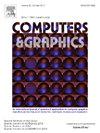基于语义感知的分层聚类室内场景逆向渲染
IF 2.8
4区 计算机科学
Q2 COMPUTER SCIENCE, SOFTWARE ENGINEERING
引用次数: 0
摘要
将场景分解为其材料属性和照明,考虑到室内环境的几何形状和多视图HDR观察,是计算机视觉和图形学中一个基本但具有挑战性的问题。现有的方法与神经渲染技术相结合,在特定对象的场景中显示出有希望的结果,但在复杂的室内场景中,材料估计往往存在不一致性。此外,照明和材料属性之间经常出现歧义。为了解决这些限制,我们提出了一种基于分解反向路径跟踪(FIPT)的自适应反向渲染管道,该管道结合了语义感知的分层聚类方法。这种增强功能使光照和材料特性的分离成为可能,有助于对反照率、粗糙度和金属特性进行更准确和一致的估计。此外,我们还引入了体素网格滤波器来进一步减少计算时间。合成和现实世界房间尺度场景的实验结果表明,与最先进的方法相比,我们的方法产生了更准确的材料估计。此外,我们通过几个应用程序展示了我们的方法的潜力,包括新的视图合成,对象插入和重照明。本文章由计算机程序翻译,如有差异,请以英文原文为准。

Semantic-aware hierarchical clustering for inverse rendering in indoor scenes
Decomposing a scene into its material properties and illumination, given the geometry and multi-view HDR observations of an indoor environment, is a fundamental yet challenging problem in computer vision and graphics. Existing approaches, combined with neural rendering techniques, have shown promising results in object-specific scenarios but often struggle with inconsistencies in material estimation within complex indoor scenes. Besides, ambiguities frequently arise between lighting and material properties. To address these limitations, we propose an adaptive inverse rendering pipeline based on Factorized Inverse Path Tracing (FIPT) that incorporates a semantic-aware hierarchical clustering approach. This enhancement enables the disentanglement of lighting and material properties, facilitating more accurate and consistent estimations of albedo, roughness, and metallic characteristics. Additionally, we introduce a voxel grid filter to further reduce computational time. Experimental results on both synthetic and real-world room-scale scenes demonstrate that our method produces more accurate material estimations compared to state-of-the-art methods. Furthermore, we demonstrate the potential of our method through several applications, including novel view synthesis, object insertion, and relighting.
求助全文
通过发布文献求助,成功后即可免费获取论文全文。
去求助
来源期刊

Computers & Graphics-Uk
工程技术-计算机:软件工程
CiteScore
5.30
自引率
12.00%
发文量
173
审稿时长
38 days
期刊介绍:
Computers & Graphics is dedicated to disseminate information on research and applications of computer graphics (CG) techniques. The journal encourages articles on:
1. Research and applications of interactive computer graphics. We are particularly interested in novel interaction techniques and applications of CG to problem domains.
2. State-of-the-art papers on late-breaking, cutting-edge research on CG.
3. Information on innovative uses of graphics principles and technologies.
4. Tutorial papers on both teaching CG principles and innovative uses of CG in education.
 求助内容:
求助内容: 应助结果提醒方式:
应助结果提醒方式:


